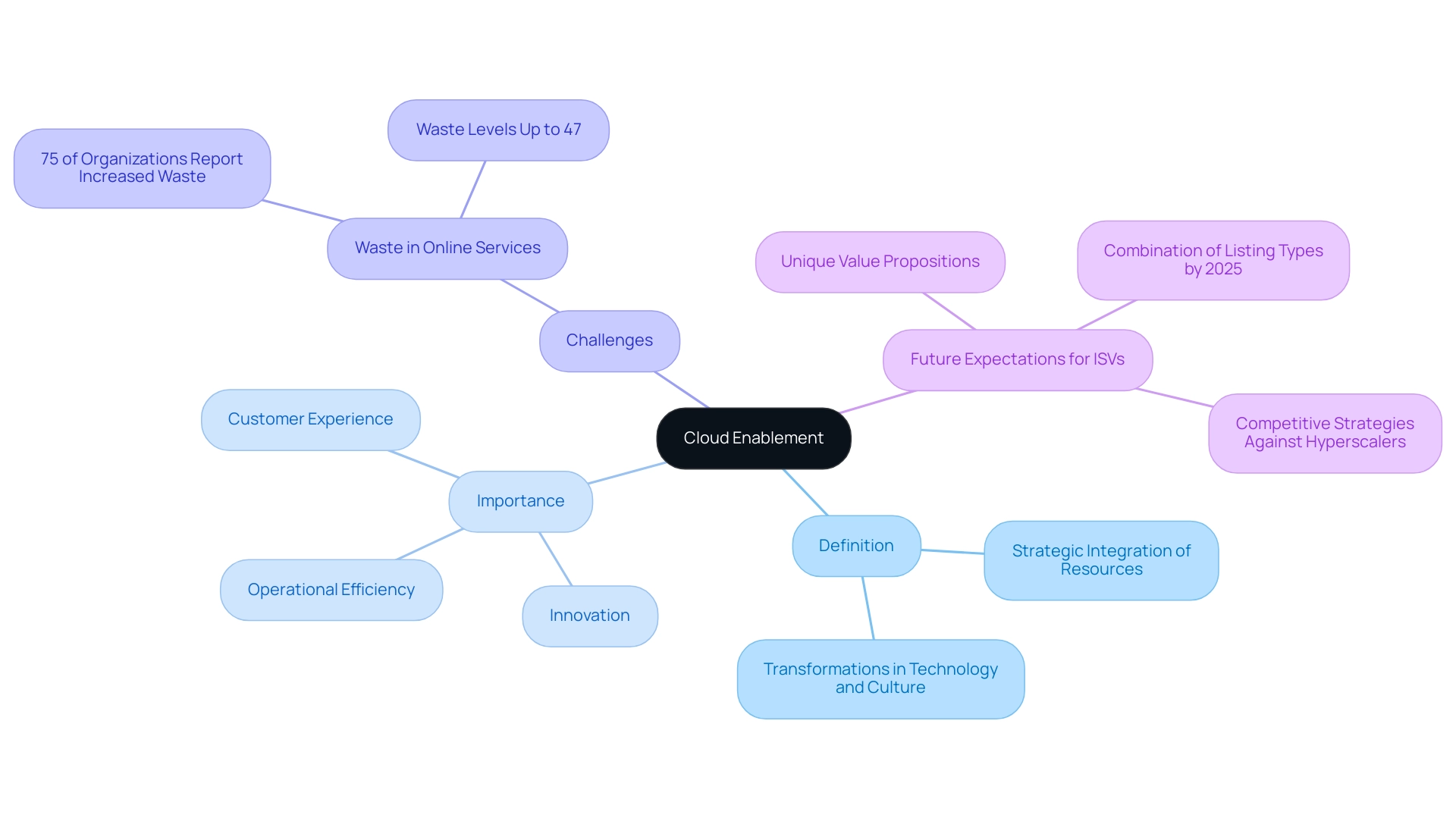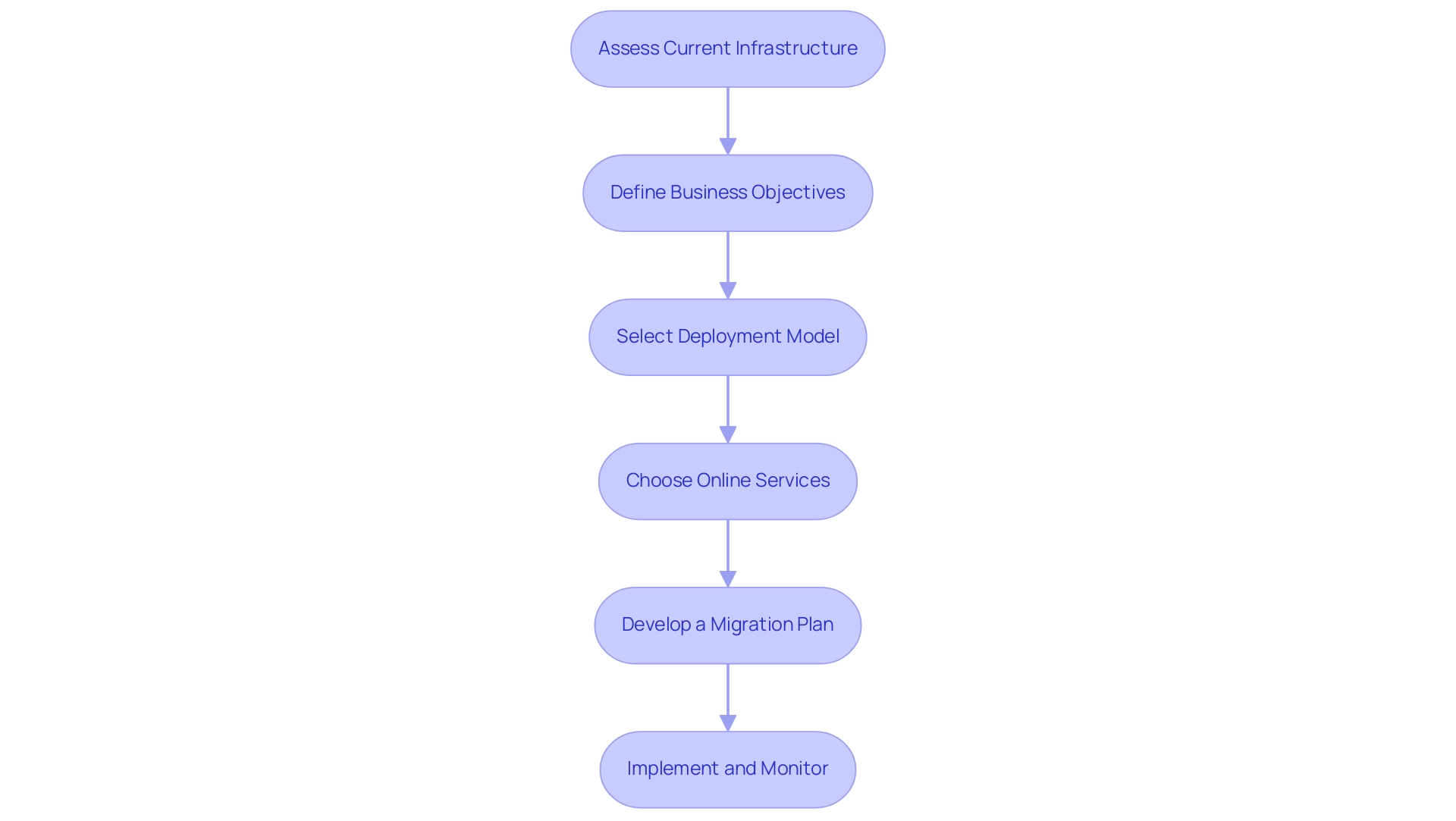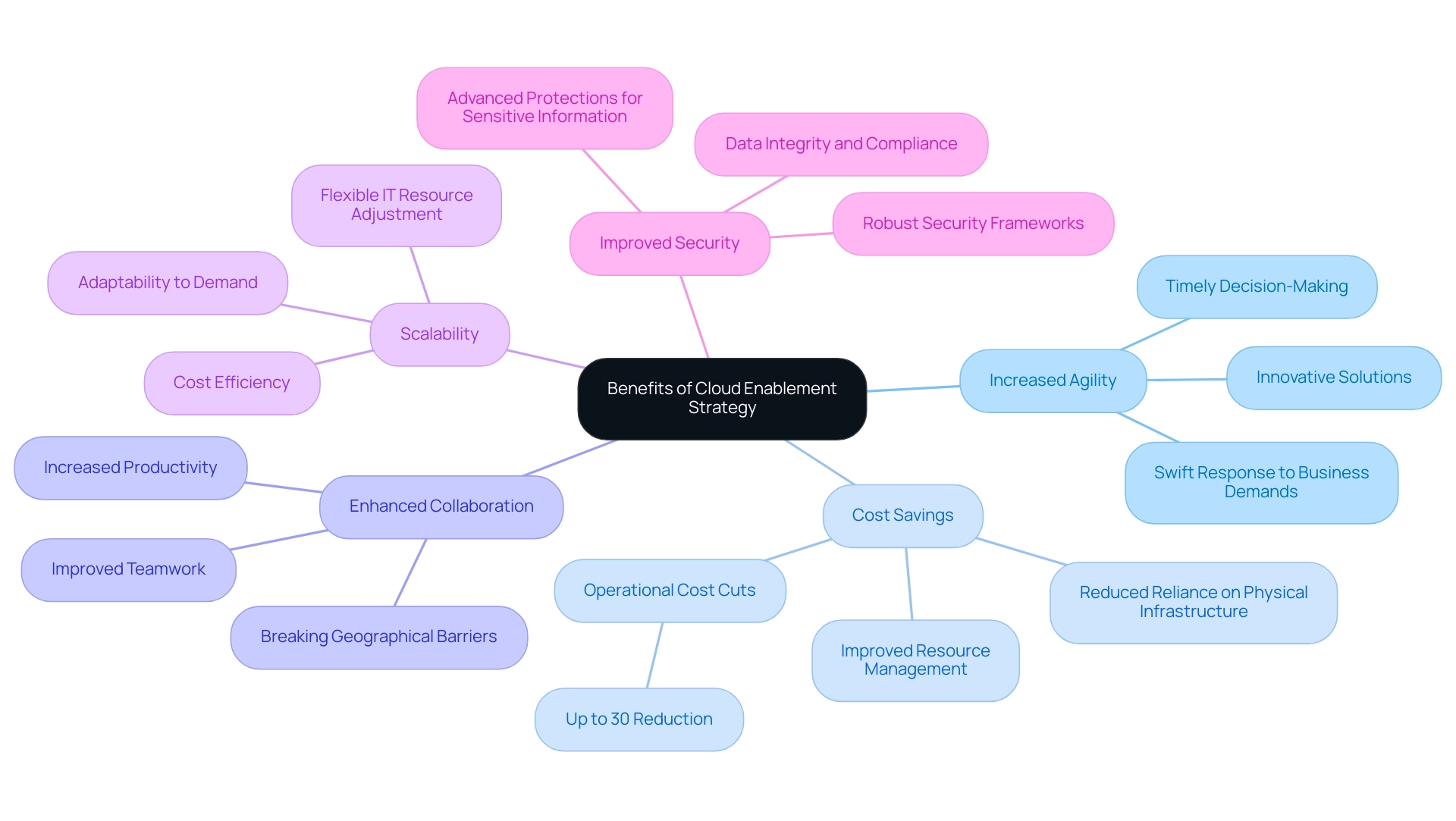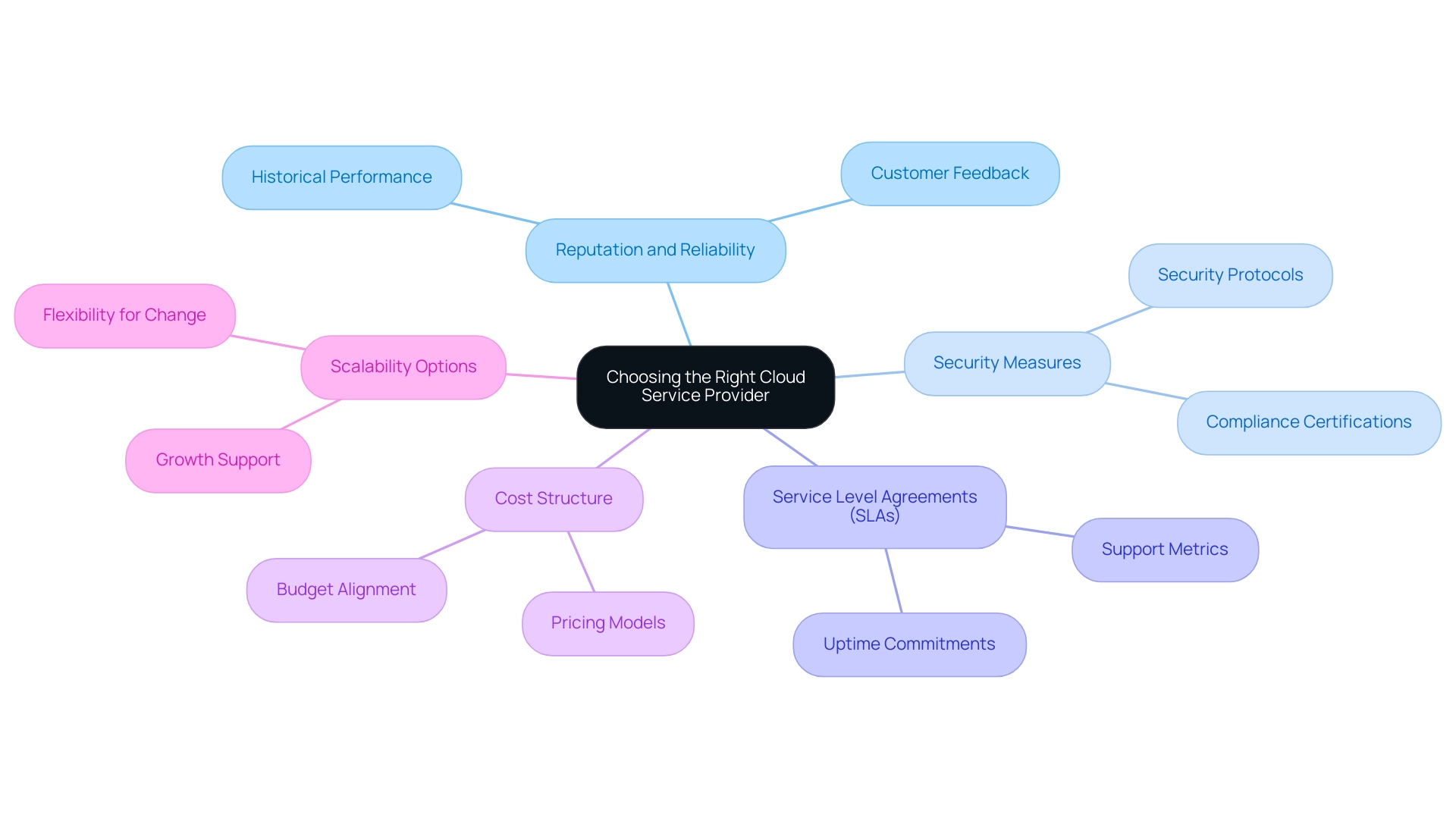Introduction
The rapid evolution of technology has ushered in a new era for organizations, where cloud enablement stands as a pivotal strategy for success. This concept transcends mere adoption of cloud services; it embodies a comprehensive transformation of infrastructure, processes, and corporate culture to fully harness the benefits of cloud computing. As businesses strive to enhance operational efficiency, drive innovation, and improve customer experiences, understanding the intricacies of cloud enablement becomes essential.
The challenges that accompany this transition, including resistance to change and data security concerns, are significant yet manageable with a well-structured approach. This article delves into the definition and importance of cloud enablement, offers a step-by-step guide for implementation, navigates the challenges organizations may face, and highlights the myriad benefits of adopting a robust cloud enablement strategy.
By equipping themselves with the right knowledge and tools, organizations can position themselves to thrive in an increasingly competitive landscape.
Understanding Cloud Enablement: Definition and Importance
Cloud facilitation is the strategic integration of computing resources into an organization's existing infrastructure and operations. This process involves essential transformations in technology, processes, and corporate culture to effectively utilize online services. The importance of a cloud enablement strategy is manifold, primarily focusing on its capacity to enhance operational efficiency, drive innovation, and elevate customer experiences.
Organizations that commit to digital enablement can swiftly adapt to market dynamics, optimize resource allocation, and substantially lower costs associated with traditional IT infrastructures. However, as the landscape changes, entities must also be attentive to the challenges that come with digital integration. Significantly, a recent study indicated that 75% of organizations experienced an increase in waste associated with online services, with waste levels in some budgets reaching as high as 47%.
This statistic emphasizes the essential requirement for strong cloud enablement strategies that are in harmony with overarching organizational goals. As John Jahnke, CEO at Tackle, states, 'We quote data and findings from multiple sources in this report and are thankful for the valuable insights.' Looking ahead to 2024, the significance of online computing in business operations remains crucial.
Most Independent Software Vendors (ISVs) are expected to adopt various listing types by the end of 2025 to demonstrate unique value propositions and remain competitive, amidst the tension they face with hyperscalers. Grasping the foundations of a cloud enablement strategy is crucial for organizations aiming to leverage its full potential.

Step-by-Step Guide to Implementing a Cloud Enablement Strategy
-
Assess Current Infrastructure: The first step in your technology enablement journey involves a thorough evaluation of your existing IT infrastructure. Identify key areas that stand to benefit from integration, focusing on performance metrics, scalability potential, and security protocols. Identifying these elements is essential, particularly as around half of the surveyed enterprises now view their cloud enablement strategy as a contemporary data protection approach for disaster recovery. This evaluation aids in confirming that your infrastructure is prepared to support a cloud enablement strategy effectively.
-
Define Business Objectives: It is essential to clearly articulate the business goals you wish to achieve through digital enablement. Common objectives include cost reduction, improved operational agility, and enhanced customer service. Establishing these goals will assist in aligning your cloud enablement strategy with the broader organizational aims.
-
Select Deployment Model: Choosing the right deployment model—public, private, or hybrid—should be based on your organization’s specific needs. Consider compliance requirements and data sensitivity when making this decision, as these factors play a critical role in the success of your digital strategy.
-
Choose Online Services: Identify which online services (Infrastructure as a Service, Platform as a Service, Software as a Service) will best support your business objectives and infrastructure needs. This selection process is essential for maximizing the benefits of the cloud enablement strategy.
-
Develop a Migration Plan: Craft a detailed migration strategy that outlines the project’s timelines, resource allocations, and risk management tactics. This strategic approach is essential; organizations like Drift have successfully decreased their annual expenses for online services by $2.4 million through their cloud enablement strategy, while Applause achieved a 23% reduction in spending for these services, showcasing effective cost management strategies.
-
Implement and Monitor: Once your migration plan is in place, execute the strategy while continuously monitoring performance metrics. Adjustments may be necessary to ensure a smooth transition and to mitigate any unforeseen challenges. As StormForge notes, many companies have observed that increased spending on digital services often correlates with increased waste, highlighting the importance of ongoing oversight and optimization to avoid unnecessary costs.

Navigating Challenges in Cloud Enablement
Organizations navigating the landscape of digital enablement encounter several critical challenges that must be addressed to achieve successful deployment.
- Resistance to Change: A significant barrier is the inherent resistance from employees towards adopting new technologies. Data suggest that overcoming this resistance is crucial, as 75% of enterprises report a rise in waste, with some budgets facing waste levels as high as 47%.
This resistance can lead to inefficiencies, making it crucial to implement effective change management practices, including training and support, to facilitate smoother transitions and foster a culture of innovation. Furthermore, as highlighted by Cody Slingerland, combined, two regions account for 82% of the world’s computing services, underscoring the importance of widespread adoption and the need to address resistance effectively.
- Data Security Concerns: Protecting information in online storage is a paramount concern for organizations.
As we approach 2024, it is vital to implement robust security measures, such as encryption and multi-factor authentication, alongside compliance protocols to protect sensitive information. In fact, expert opinions emphasize that effective data security strategies can significantly reduce risks associated with computing.
- Integration Issues: The difficulties of merging legacy systems with online resources pose another challenge.
A thorough assessment and planning phase are essential to identify potential integration risks and devise strategies to address them. Effective integration guarantees that companies can utilize online capabilities without interrupting current operations.
- Cost Management: The ever-changing characteristics of online resources can result in unexpected expenses that pressure budgets.
To combat this, entities should regularly monitor usage and establish clear budgets to control expenses effectively. With Amazon Web Services (AWS) holding 31% of the infrastructure solutions market, comprehending cost management in relation to online resource usage becomes essential.
Moreover, studies indicate that 98% of U.S. entities have embraced online services for at least some business activities, a notable rise from 91% in 2020, demonstrating an increasing dependence on internet technology for diverse operational requirements. By proactively tackling these challenges, companies can improve their cloud enablement strategy, ensuring dependable application deployment and maximizing the advantages of technology.

Benefits of Adopting a Cloud Enablement Strategy
Executing a cloud enablement strategy offers numerous benefits that can greatly improve an organization’s operational framework. Among these benefits are:
- Increased Agility: Organizations can swiftly respond to evolving business demands and market dynamics, allowing for timely decision-making and innovative solutions.
- Cost Savings: Switching to online solutions decreases reliance on physical infrastructure, which can result in significant cuts in operational costs and improved resource management. Recent studies suggest that companies utilizing online technology can achieve cost reductions of up to 30%.
- Enhanced Collaboration: Cloud platforms break down geographical barriers, fostering improved teamwork and communication among dispersed teams, ultimately driving productivity.
- Scalability: The inherent flexibility of online services allows organizations to adjust their IT resources in alignment with demand, ensuring they only incur costs for what they utilize. This adaptability is crucial in today's fast-paced business environment, where responsiveness is key.
- Improved Security: Leading service providers are dedicated to investing in robust security frameworks, offering advanced protections for sensitive information. As Cody Slingerland observed,
Together, these two regions represent 82% of the world’s computing,
emphasizing the significance of these solutions in ensuring data integrity and compliance, which are vital for organizational growth.
Moreover, with Microsoft Azure Stack usage increasing to 37% in 2022, the trend indicates a broader transition towards online services. The case study titled 'Cloud Usage Trends' highlights that the uptake of online resources is rising among both companies and individuals, with the number of personal users of these platforms doubling from 1.1 billion in 2014 to an estimated 2.3 billion today. As the IaaS market is expected to expand at an impressive rate of over 30%, with Google Cloud's offerings increasing by 63%, businesses that embrace a cloud enablement strategy position themselves for sustained growth and competitive advantage.

Choosing the Right Cloud Service Provider for Your Needs
Choosing a cloud provider necessitates careful evaluation of several key criteria to ensure alignment with your organization’s strategic objectives and its cloud enablement strategy.
-
Reputation and Reliability: It is imperative to research the provider’s historical performance and customer feedback. A strong reputation can often reflect consistent quality, which is vital for ensuring business continuity.
-
Security Measures: Evaluate the security protocols and compliance certifications that the provider offers. This is essential in safeguarding sensitive data, especially in an era where the global smartphone user base is projected to reach approximately 7,743.6 billion by 2028, highlighting the growing volume of data at risk.
-
Service Level Agreements (SLAs): Thoroughly review SLAs to comprehend the provider’s commitments regarding uptime, support, and performance metrics. Clear SLAs are vital to ensure accountability and to set expectations for service reliability.
-
Cost Structure: Analyze the pricing models of potential providers. Understanding the cost implications in relation to expected usage helps prevent unforeseen expenses and ensures budget alignment.
-
Scalability Options: It is crucial to determine whether the provider can support your organization’s growth and adapt to changing needs over time. A scalable solution allows for flexibility as business demands evolve.
Mariusz Michalowski, Community Manager at Spacelift, highlights the significance of automation and DevOps in this process, stating, 'Selecting the appropriate provider is essential for utilizing automation and guaranteeing smooth deployment of applications.'
By thoroughly assessing these standards, companies can make knowledgeable choices that not only fulfill their current requirements but also support their cloud enablement strategy for future success in the swiftly growing digital platform market, which is expected to increase by around 21.7% in 2023. Furthermore, the count of people utilizing personal online storage has risen from 1.1 billion in 2014 to an estimated 2.3 billion now, indicating a growing trend in digital adoption. On average, workers use 36 cloud-based services daily, and 92% of organizations employ a multicloud strategy, underscoring the relevance of carefully selecting cloud service providers.

Conclusion
The journey toward cloud enablement is not merely a technical transition but a comprehensive transformation that can redefine an organization’s operational landscape. By understanding the definition and importance of cloud enablement, organizations can recognize its potential to enhance efficiency, foster innovation, and improve customer experiences. A carefully crafted strategy that incorporates a thorough assessment of existing infrastructure, clear business objectives, and the selection of appropriate cloud services is essential for successful implementation.
However, the path to cloud enablement is fraught with challenges, including:
- Resistance to change
- Data security concerns
- Integration issues
- Cost management
Addressing these challenges through effective change management practices, robust security measures, and diligent monitoring can significantly improve the likelihood of a successful transition. As organizations increasingly rely on cloud technology, the importance of overcoming these obstacles cannot be overstated.
Ultimately, adopting a cloud enablement strategy offers substantial benefits, including:
- Increased agility
- Cost savings
- Enhanced collaboration
- Improved security
As the cloud landscape continues to evolve, organizations that embrace this strategic approach will not only position themselves for sustained growth but also gain a competitive edge in an increasingly digital marketplace. Embracing cloud enablement is not just a strategic choice; it is a vital step toward thriving in the future of business operations.




